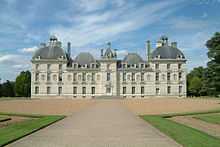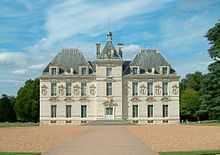Marlinspike Hall



Marlinspike Hall (French: Le château de Moulinsart) is Captain Haddock's country house in The Adventures of Tintin, the comics series by Belgian cartoonist Hergé.[1]
The hall is modeled after the central section of the Château de Cheverny. The French name is derived from Sart-Moulin, a village near Braine-l'Alleud in Walloon Brabant, Belgium; in an allusion to the Haddock family's maritime history, the hall's English name refers to the Marlinspike, a tool used in seamanship to splice ropes.
History
Marlinspike Hall first appears in The Secret of the Unicorn as the home of the story's villains, the Bird brothers.[2] At the end of Red Rackham's Treasure, the manor (found to have been built by an illustrious ancestor of Haddock's) is purchased by Professor Calculus on behalf of the Captain; the fabled treasure itself is found hidden in the manor's old chapel, in the cellars.[2][1] In the following years, Marlinspike provides a home base for Tintin and Haddock in between their various adventures. In The Castafiore Emerald, virtually all of the action takes place in the hall, its grounds, or the surrounding countryside.[3]
Description
Marlinspike Hall is presented as a large and luxurious dwelling adorned with numerous works of art, antique furniture, and a gallery of the Haddock family's treasures. The grounds comprise a park with extensive woodlands, wide lawns, a rose garden, a high surrounding wall, at least two gates, a neighbouring meadow, and at least one adjacent building (used by Professor Calculus as a laboratory in The Calculus Affair ). The size of the house and park would appear to require a number of domestic and gardening staff but only one—-the faithful Nestor, who serves as butler to the Hall—-is ever seen.[nb 1]
In Land of Black Gold Calculus blows up parts of the hall while conducting experiments to try and find an antidote to a chemical that causes fuel to become explosive.
The Belgian corporation organized to manage the rights to Hergé's work (principally Tintin) is called Moulinsart S.A. after the name of Marlinspike in the original French.
Location
The original English language translators of the Tintin books caused some confusion by giving the address of Marlinspike Hall as "Marlinshire, England" in The Secret of the Unicorn. However details such as traffic travelling on the right hand side of the road and the appearance of the Marlinspike police (who wear the black and red uniforms of the Belgian Gendarmerie) confirm that Hergé's intention was to locate the Hall in his native Belgium. Moreover, it is explained in The Red Rackham's Treasure that the Manor was built by an ancestor of Captain Haddock's, the Chevalier François de Hadoque, a Ship-of-the-Line Captain in La Royale under King Louis XIV. In the Golden Press editions, the name is Americanized to Hudson Manor, suggesting a location along the Hudson River in the state of New York.
Translations
- Arabic: Mulan
- Bengali: মার্লিনস্পাইক (Marlinspike)
- Catalan: Molins de dalt
- Chinese: 马林斯派克(Marlinspike) or 穆蘭薩城堡(Moulinsart)
- Danish: Møllenborg Slot (literally: Millburg Castle)
- Dutch: Kasteel Molensloot
- Finnish: Moulinsartin linna
- French: Château de Moulinsart (original)
- German: Schloss Mühlenhof (literally: Millfarm Castle)
- Icelandic: Myllusetur
- Indonesian:Puri Moulinsart
- Italian: Castello di Moulinsart
- Japanese: ムーランサール城 (Mūransāru-jō)
- Persian: کاخ مولنسار (Ka'kh-e-Moulansar)
- Polish: Księżymłyn
- Portuguese: Castelo de Moulinsart
- Russian: Замок Муленсар
- Spanish: Castillo de Moulinsart, Castillo del Molino, Mansión Pasador
- Swedish: Moulinsarts slott
- Turkish: Mulensar Şatosu
Notes
- ↑ Although a gardener is mentioned once in the last pages of The Red Sea Sharks.
Citations
Sources
- Farr, Michael (2011) [First published 2001 by John Murray Publishers Ltd]. Tintin: The Complete Companion. Last Gasp. ISBN 978-0-86719-754-9.
- Lofficier, Jean-Marc; Lofficier, Randy (2007) [First published 2002]. The Pocket Essential Tintin. Harpenden, Hertfordshire: Pocket Essentials. ISBN 978-1-84243-226-6.